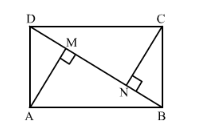$A B C D$ is a rectangle. Points $M$ and $N$ are on $B D$ such that $A M \perp B D$ and $C N \perp B D$. Prove that $B M^{2}+B N^{2}=D M^{2}+D N^{2}$.
Given: A rectangle ABCD where AM ⊥ BD and CN ⊥ BD.
To prove: $\mathrm{BM}^{2}+\mathrm{BN}^{2}=\mathrm{DM}^{2}+\mathrm{DN}^{2}$
Proof:

Apply Pythagoras Theorem in $\triangle \mathrm{AMB}$ and $\triangle \mathrm{CND}$,
$\mathrm{AB}^{2}=\mathrm{AM}^{2}+\mathrm{MB}^{2}$
$\mathrm{CD}^{2}=\mathrm{CN}^{2}+\mathrm{ND}^{2}$
Since $A B=C D, A M^{2}+M B^{2}=C N^{2}+N D^{2}$
$\Rightarrow \mathrm{AM}^{2}-\mathrm{CN}^{2}=\mathrm{ND}^{2}-\mathrm{MB}^{2} \ldots$ (i)
Again apply Pythagoras Theorem in $\triangle A M D$ and $\triangle C N B$,
$\mathrm{AD}^{2}=\mathrm{AM}^{2}+\mathrm{MD}^{2}$
$\mathrm{CB}^{2}=\mathrm{CN}^{2}+\mathrm{NB}^{2}$
Since $A D=B C, A M^{2}+M D^{2}=C N^{2}+N B^{2}$
$\Rightarrow \mathrm{AM}^{2}-\mathrm{CN}^{2}=\mathrm{NB}^{2}-\mathrm{MD}^{2} \ldots$ (ii)
Equating (i) and (ii),
$\mathrm{ND}^{2}-\mathrm{MB}^{2}=\mathrm{NB}^{2}-\mathrm{MD}^{2}$
I.e., $B M^{2}+B N^{2}=D M^{2}+D N^{2}$
This proves the given relation.
Click here to get exam-ready with eSaral
For making your preparation journey smoother of JEE, NEET and Class 8 to 10, grab our app now.
